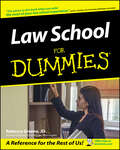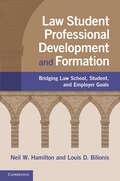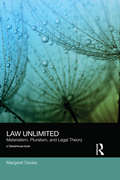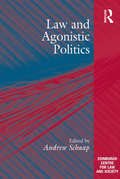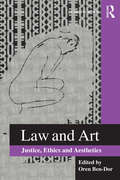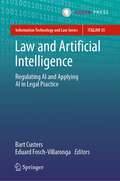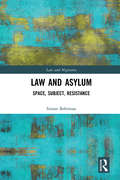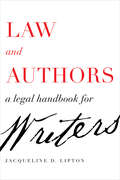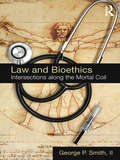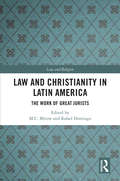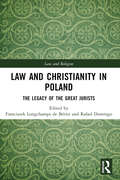- Table View
- List View
Law School Exams: Preparing and Writing to Win
by Charles CallerosOverview Law School Study Techniques Preparing for Exams Taking Law School Exams
Law School For Dummies
by Rebecca Fae GreeneThe straightforward guide to surviving and thriving in law school Every year more than 40,000 students enter law school and at any given moment there are over 125,000 law school students in the United States. Law school's highly pressurized, super-competitive atmosphere often leaves students stressed out and confused, especially in their first year. Balancing life and schoolwork, passing the bar, and landing a job are challenges that students often need help facing. In Law School For Dummies, former law school student Rebecca Fae Greene uses straight talk, sound advice, and gentle humor to help students sort through the swamp of coursework and focus on what's important-all while maintaining a life. She also offers rare insight on the law school experience for women, minorities, non-traditional, and non-Ivy League students.
Law School Without Fear: Strategies For Success
by Helene Shapo Marshall ShapoWith a total of 50 years of experience teaching law school between them, the authors of Law School Without Fear offer law students strategies for coping with law school successfully and advice on how to get the most out the law school experience. The book discusses in simple terms what students need to know about law school, covering common problems that law students encounter and solutions to those problems. Topics covered include briefing a case, precedent and how to use it, balancing competing interests and factors, legal writing, and psychological tips for the study of law. Special features include a comprehensive approach to the first year, from the bewildering first day of class through examinations; advice on how to study, how to deal with the classroom experience, and how to take exams; wonderfully brief summaries of fundamental ideas of policy common to almost all law classes; and glossary of frequently used words and phrases.
Law School: How to Get in, Get Through, and Get Practicing
by Michael J. Reppas II<p>Filled with personal anecdotes about his law school years, Law School, How to Get in, Get Through, and Get Practicing, by Michael J. Reppas II, Esq., offers all future law students a peek into the ever-surprising, nerve-racking, adventure known as law school, where no book is left unturned and no hour spent resting. This is your law school guide from start to finish. <p>You'll laugh at the author's own experiences as a fledgling one-L and read how he gains the confidence and skill to land a spot at the prestigious Law Review, get published, get awards, pass the bar, and become an attorney. You'll be entertained while gaining valuable insight into what it really takes to get into law school, get through it, and get practicing! <p>Your first mistake before going to law school would be to not read this book! Your second mistake would be to not read this book a second time. When you're finished you'll want to experience it all for yourself.</p>
Law Student Professional Development and Formation: Bridging Law School, Student, and Employer Goals
by Neil W. Hamilton Louis D. BilionisLaw schools currently do an excellent job of helping students to 'think like a lawyer,' but empirical data show that clients, legal employers, and the legal system need students to develop a wider range of competencies. This book helps legal educators to understand these competencies and provides practical ways to build them into a law school curriculum. Based on recommendations from the American Bar Association, the American Association of Law Schools, and the Carnegie Foundation for the Advancement of Teaching, it will equip students with the skills they need not only to think but to act and feel like a lawyer. With this proposed model, students will internalize the need for professional development toward excellence, their responsibility to others, a client-centered approach to problem solving, and strong well-being practices. These four goals constitute a lawyer's professional identity, and this book empowers legal educators to foster each student's development of a professional identity that leads to a gratifying career that serves society well. This title is Open Access.
Law Through the Life Course
by Jonathan HerringCourt decisions are typically seen as one-off interventions relating to an incident in a person’s life, but a legal decision can impact on the person as they were and the person they will become. This book is the first to explore the interactions of the law with the life course in order to understand the complex life journey as a whole. Jonathan Herring reveals how the law privileges ‘middle age’ to the detriment of the whole life story and explains why an understanding of the life course is important for lawyers. Relevant to those working in family law, elder law, medical law and ethics, jurisprudence, gender and the law, it will promote new thinking by exploring the engagement of the law with the life course of the self.
Law Unlimited (Social Justice)
by Margaret DaviesThis book engages with a traditional yet persistent question of legal theory – what is law? However, instead of attempting to define and limit law, the aim of the book is to unlimit law, to take the idea of law beyond its conventionally accepted boundaries into the material and plural domains of an interconnected human and nonhuman world. Against the backdrop of analytical jurisprudence, the book draws theoretical connections and continuities between different experiences, spheres, and modalities of law. Taking up the many forms of critical and socio-legal thought, it presents a broad challenge to legal essentialism and abstraction, as well as an important contribution to more general normative theory. Reading, crystallising, and extending themes that have emerged in legal thought over the past century, this book is the culmination of the author’s 25 years of engagement with legal theory. Its bold attempt to forge a thoroughly contemporary approach to law will be of enormous value to those with interests in legal and socio-legal theory.
Law Without Lawyers, Justice Without Courts: On Traditional Chinese Mediation
by Bee Chen GohThe Chinese have, since ancient times, professed a non-litigious outlook. Similarly, their preference for mediation has fascinated the West for centuries. Mediation has been popularized by the Chinese who subscribe to the Confucian notions of harmony and compromise. It has been perpetuated in the People's Republic of China and by the overseas Chinese communities elsewhere, such as in Malaysia and Taiwan. Seen as the chief contributing factor in their litigation-averse nature, as well as the reason behind the significant role given to traditional mediation, this compelling book traces the cultural tradition of the Chinese. It uses rural Chinese Malaysians as illustrative examples and offers new insights into the nature of mediation East and West. It is an important reference and essential resource for anyone keen to learn about traditional Chinese concepts of law, justice and dispute settlement. Equally, it makes a unique contribution to the existing ADR literature by undertaking a socio-legal study on traditional Chinese mediation.
Law Without Lawyers: A Comparative View Of Law In The United States And China
by Victor H. LiThe U.S. has 400,000 lawyers in a society of 200 million people. China, a country with four times that population, has a mere 3,500 lawyers. How do the Chinese achieve law without lawyers? Victor Li, one of the world's leading authorities on Chinese law, explores the way the Chinese and U.S. systems have historically viewed law (and still view it), and the way each system functions in everyday life to shape conduct and control deviance. In a straightforward and highly readable manner, the author examines how these highly divergent societies operate. He writes about historical forces and cultural values that are centuries old—and that are still critical influences in shaping life in modern America and China. In explaining the differences in the tradition and operation of law in these two cultures, Li gives us both an invaluable understanding of Chinese society today and his own appraisal of the strengths and weaknesses of U.S. law, lawyers, and courts.
Law after Ground Zero
by John StrawsonFollowing the events of September 11, a new legal order is emerging in which the 'terrorist threat' has been used as justification to marginalise human rights. This collection of themed essays offers an emphatic defence to the threats confronting our human rights culture. In analysing the role of the United Nations, the conduct of the Afghan war, domestic anti-terrorist legislation and the new debate about Islamic law, Law after Ground Zero demonstrates the future challenges that law will face within our global society. It also offers accounts of how events have impacted on the Palestinian-Israeli conflict, Iraq and Afghanistan itself, as well as debates about international law, human rights and women's rights. This unique work will interest those studying or researching in the areas of international law, human rights and humanitarian law, international relations, politics, critical legal studies, Islamic law, culture and socio-legal studies.
Law against the State
by Brian Donahoe Zerrin Özlem Biner Julia Eckert Christian StrümpellThis collection of rich, empirically grounded case studies investigates the conditions and consequences of 'juridification' – the use of law by ordinary individuals as a form of protest against 'the state'. Starting from the actual practices of claimants, these case studies address the translation and interpretation of legal norms into local concepts, actions and practices in a way that highlights the social and cultural dynamism and multivocality of communities in their interaction with the law and legal norms. The contributors to this volume challenge the image of homogeneous and primordially norm-bound cultures that has been (unintentionally) perpetuated by some of the more prevalent treatments of law and culture. This volume highlights the heterogeneous geography of law and the ways boundaries between different legal bodies are transcended in struggles for rights. Contributions include case studies from South Africa, Malawi, Sierra Leone, Turkey, India, Papua New Guinea, Suriname, the Marshall Islands and Russia.
Law and Acculturation: Conceptualisation and Empirical Case Study: Slavic Migrants in Poland
by Jan Bazyli KlaklaThis book is one of the first attempts to directly explore the relationship between law and acculturation. By exploring the theoretical basis of the concept of culture, the ideas of law and various models of acculturation, it brings a nuanced theorization and problematization of the intricate connection between law and acculturation. It does this through theory and then presents the findings of the author’s qualitative empirical study conducted with a group of long-term Slavic migrants residing in Poland. The book culminates by demonstrating how the law can be integrated into one of the theoretical models of acculturation, specifically the Relative Acculturation Extended Model.
Law and Administration (Law in Context)
by Richard Rawlings Carol HarlowLaw and Administration takes a contextual approach to administrative law, setting law and legal rules in the context of the social, political and economic forces that shape the law, and of the complex constitutional framework in which contemporary administrative law operates. This book contains a full account of judicial review, the traditional heartland of administrative law, and adds to this by taking into account the concerns of government, officials and agencies who operate and shape the law. It also looks at the possible future of administrative law in an increasingly automated and digitalised world. A fully revised and updated new edition, this book includes new case studies of regulatory agencies and government contracting to develop understanding of law in practice.
Law and Agonistic Politics (Edinburgh/glasgow Law And Society Ser.)
by Andrew SchaapThe Ancient Greek notion of agonism, meaning struggle, has been revived in radical legal and political theory to rethematize class conflict and to conceptualize the conditions of possibility of freedom and social transformation in contemporary society. Insisting that what is ultimately at stake in politics are the terms in which social conflict is represented, agonists highlight the importance of the strategic, affective and aesthetic aspects of politics for democratic praxis. This volume examines the implications of this critical perspective for understanding law and considers how law serves either to sustain or curtail the democratic agon. While sharing a critical perspective on the deliberative turn in legal and political theory and its tendency to depoliticize social conflict, the various contributors to this volume diverge in arguing variously for pragmatic, expressivist or strategic conceptions of agonism. In doing so they question the glib assumptions that often underlie a sometimes too easy celebration of conflict as an antidote to de-politicizing consensus. This thought provoking volume will be of interest to students and researchers working in legal and political theory and philosophy.
Law and Agroecology
by Massimo Monteduro Pierangelo Buongiorno Saverio Benedetto Alessandro IsoniThis book represents a first attempt to investigate the relations between Law and Agroecology. There is a need to adopt a transdisciplinary approach to multifunctional agriculture in order to integrate the agroecological paradigm in legal regulation. This does not require a super-law that hierarchically purports to incorporate and supplant the existing legal fields; rather, it calls for the creation of a trans-law that progressively works to coordinate interlegalities between different legal fields, respecting their autonomy but emphasizing their common historical roots in rus in the process. Rus, the rural phenomenon as a whole, reflects the plurality and interdependence of different complex systems based jointly on the land as a central point of reference. "Rural" is more than "agricultural": if agriculture is understood traditionally as an activity aimed at exploiting the land for the production of material goods for use, consumption and private exchange, rurality marks the reintegration of agriculture into a broader sphere, one that is not only economic, but also social and cultural; not only material, but also ideal, relational, historical, and symbolic; and not only private, but also public. In approaching rus, the natural and social sciences first became specialized, multiplied, and compartmentalized in a plurality of first-order disciplines; later, they began a process of integration into Agroecology as a second-order, multi-perspective and shared research platform. Today, Agroecology is a transdiscipline that integrates other fields of knowledge into the concept of agroecosystems viewed as socio-ecological systems. However, the law seems to still be stuck in the first stage. Following a reductionist approach, law has deconstructed and shattered the universe of rus into countless, disjointed legal elementary particles, multiplying the planes of analysis and, in particular, keeping Agricultural Law and Environmental Law two separate fields.
Law and Art: Justice, Ethics and Aesthetics
by Oren Ben-DorIn engaging with the full range of 'the arts', contributors to this volume consider the relationship between law, justice, the ethical and the aesthetic. Art continually informs the ethics of a legal theory concerned to address how theoretical abstractions and concrete oppressions overlook singularity and spontaneity. Indeed, the exercise of the legal role and the scholarly understanding of legal texts were classically defined as ars iuris - an art of law - which drew on the panoply of humanist disciplines, from philology to fine art. That tradition has fallen by the wayside, particularly in the wake of modernism. But approaching art in that way risks distorting the very inexpressibility to which art is attentive and responsive, whilst remaining a custodian of its mystery. The novelty and ambition of this book, then, is to elicit, in very different ways, styles and orientations, the importance of the relationship between law and art. What can law and art bring to one another, and what can their relationship tell us about how truth relates to power? The insights presented in this collection disturb and supplement conventional accounts of justice; inaugurating new possibilities for addressing the origin of violence in our world.
Law and Artificial Intelligence: Regulating AI and Applying AI in Legal Practice (Information Technology and Law Series #35)
by Bart Custers Eduard Fosch-VillarongaThis book provides an in-depth overview of what is currently happening in the field of Law and Artificial Intelligence (AI). From deep fakes and disinformation to killer robots, surgical robots, and AI lawmaking, the many and varied contributors to this volume discuss how AI could and should be regulated in the areas of public law, including constitutional law, human rights law, criminal law, and tax law, as well as areas of private law, including liability law, competition law, and consumer law. Aimed at an audience without a background in technology, this book covers how AI changes these areas of law as well as legal practice itself. This scholarship should prove of value to academics in several disciplines (e.g., law, ethics, sociology, politics, and public administration) and those who may find themselves confronted with AI in the course of their work, particularly people working within the legal domain (e.g., lawyers, judges, law enforcement officers, public prosecutors, lawmakers, and policy advisors).Bart Custers is Professor of Law and Data Science at eLaw - Center for Law and Digital Technologies at Leiden University in the Netherlands.Eduard Fosch-Villaronga is Assistant Professor at eLaw - Center for Law and Digital Technologies at Leiden University in the Netherlands.
Law and Asylum: Space, Subject, Resistance (Law and Migration)
by Simon BehrmanIn contrast to the claim that refugee law has been a key in guaranteeing a space of protection for refugees, this book argues that law has been instrumental in eliminating spaces of protection, not just from one’s persecutors but also from the grasp of sovereign power. By uncovering certain fundamental aspects of asylum as practised in the past and in present day social movements, namely its concern with defining space rather than people and its role as a space of resistance or otherness to sovereign law, this book demonstrates that asylum has historically been antagonistic to law and vice versa. In contrast, twentieth-century refugee law was constructed precisely to ensure the effective management and control over the movements of forced migrants. To illustrate the complex ways in which these two paradigms – asylum and refugee law – interact with one another, this book examines their historical development and concludes with in-depth studies of the Sanctuary Movement in the United States and the Sans-Papiers of France. The book will appeal to researchers and students of refugee law and refugee studies; legal and political philosophy; ancient, medieval and modern legal history; and sociology of political movements.
Law and Authority in British Legal History, 1200–1900
by Mark GodfreyBy presenting original research into British legal history, this volume emphasises the historical shaping of the law by ideas of authority. The essays offer perspectives upon the way that ideas of authority underpinned the conceptualisation and interpretation of legal sources over time and became embedded in legal institutions. The contributors explore the basis of the authority of particular sources of law, such as legislation or court judgments, and highlight how this was affected by shifting ideas relating to concepts of sovereignty, religion, political legitimacy, the nature of law, equity and judicial interpretation. The analysis also encompasses ideas of authority which influenced the development of courts, remedies and jurisdictions, international aspects of legal authority when questions of foreign law or jurisdiction arose in British courts, the wider authority of systems of legal ideas such as natural law, the authority of legal treatises, and the relationship between history, law and legal thought.
Law and Authors: A Legal Handbook for Writers
by Jacqueline D. LiptonThis accessible, reader-friendly handbook will be an invaluable resource for authors, agents, and editors in navigating the legal landscape of the contemporary publishing industry. Drawing on a wealth of experience in legal scholarship and publishing, Jacqueline D. Lipton provides a useful legal guide for writers whatever their levels of expertise or categories of work (fiction, nonfiction, or academic). Through case studies and hypothetical examples, Law and Authors addresses issues of copyright law, including explanations of fair use and the public domain; trademark and branding concerns for those embarking on a publishing career; laws that impact the ways that authors might use social media and marketing promotions; and privacy and defamation questions that writers may face. Although the book focuses on American law, it highlights key areas where laws in other countries differ from those in the United States. Law and Authors will prepare every writer for the inevitable and the unexpected.
Law and Bioethics: Intersections Along the Mortal Coil
by George P. Smith IIGeorge P. Smith, II is a leading figure in the world of medical law and ethics. During his long career he has addressed some of the most important issues in bioethics and has contributed much original thought to debates in the field. This book celebrates his contribution to scholarship in this area and brings together his key writings in bioethics. The chapters include previously published material which has been substantially updated to reflect recent developments in medicine and law. The book covers topics such as: human rights and medical law; the allocation of resources and distributive justice; ethical relativism; science and religion; and public health emergencies. Taken as a whole, this book examines the extent to which law, medicine, economics, and bioethics interact as synergistic vectors of force in shaping and setting both personal and public responses to the complexities of biotechnology, or what has been referred to as "The New Biology." All too often, past considerations of this topic have neglected to recognise the synergistic influences of law as a catalyst for codifying contemporary values into normative standards. Professor Smith reaches the conclusion that if traditional bioethical principles are to be seen as pertinent constructs for policy making, they must be broadened through the law of public health and Human rights. Law and Bioethics: Intersections along the Mortal Coil casts law as the pivotal force in bringing stability to the ongoing debates on how to maintain bioethical relevance in decision making and in so doing, it offers an excellent overview of the current bioethical issues in medical law considered in light of recent and ongoing technological developments in medicine. This book will be of particular interest to academics and students of Law, Political Science, Philosophy and Economics.
Law and Business of the Entertainment Industries: Fourth Edition
by Donald E. Biederman Martin E. Silfen Robert C. Berry Edward P. Pierson Jeanne A. GlasserThis edition is divided into two parts--one dealing with general principles and the other dealing with specific entertainment and related industries.
Law and CSR in COVID and Post-COVID Times: Comparative Perspectives from the Asia-Pacific Region
by Akanksha JumdeThis book presents a comprehensive examination of the impact of COVID and post-COVID times on Corporate Social Responsibility (CSR) compliance and related legal frameworks in the Asia-Pacific region. The book utilizes various research methodologies to analyze corporates' responses to legislative and regulatory frameworks on CSR during the COVID pandemic. Focusing primarily on countries including China, India, Indonesia, and Australia, the book delves into the contrasting approaches taken by these nations in enforcing and regulating CSR. While some countries adopt hard law measures to ensure socially responsible behaviors, others rely on normative approaches such as the ASX Listing Rules. Through a combination of comparative doctrinal analysis and empirical socio-legal-based research methods, the book assesses the state of CSR compliance in selected countries. By analyzing companies' CSR disclosures and conducting interviews with stakeholders, the study identifies gaps in the existing legal literature. The book fills these gaps by offering practical recommendations to enhance policy development and strengthen the legal frameworks. It emphasizes the importance of corporate culture in influencing CSR-related activities. In conclusion, this book provides valuable insights into how companies can better comply with CSR regulations and improve their societal impact.
Law and Christianity in Latin America: The Work of Great Jurists (Law and Religion)
by M.C. Mirow and Rafael DomingoThis volume examines the lives of more than thirty-five key personalities in Latin American law with a focus on how their Christian faith was a factor in molding the evolution of law in their countries and the region. The book is a significant contribution to our ability to understand the work and perspectives of jurists and their effect on legal development in Latin America. The individuals selected for study exhibit wide-ranging areas of expertise from private law and codification, through national public law and constitutional law, to international developments that left their mark on the region and the world. The chapters discuss the jurists within their historical, intellectual, and political context. The editors selected jurists after extensive consultation with legal historians in various countries of the region looking at the jurist’s particular merits, contributions to law in general, religious perspective, and importance within the specific country and period under consideration. Giving the work a diversity of international and methodological perspectives, the chapters have been written by distinguished legal scholars and historians from Latin America and around the world. The collection will appeal to scholars, lawyers, and students interested in the interplay between law and religion. Political, social, legal, and religious historians among other readers will find, for the first time in English, authoritative treatments of the region’s essential legal thinkers and authors. Students and other who may not read Spanish will appreciate these clear, accessible, and engaging English studies of the region’s great jurists.
Law and Christianity in Poland: The Legacy of the Great Jurists (Law and Religion)
by Rafael Domingo Franciszek Longchamps de BérierThis volume is the first comprehensive study of the Polish history of law and Christianity written in English for a global audience. It examines the lives of twenty-one central figures in Polish law with a focus on how their Christian faith was a factor in molding the evolution of law in their country and the region. The individuals selected for study exhibit wide-ranging areas of expertise, from private law and codification, through national public law and constitutional law, to international developments that left their mark on Poland and the world. The chapters discuss the jurists within their historical, intellectual, and political context. The editors selected jurists after extensive consultation with legal historians looking at the jurists’ particular merits, contributions to law in general, religious perspective, and period under consideration. The collection will appeal to scholars, lawyers, and students interested in the interplay between law and religion. Political, social, legal, and religious historians, among other readers, will find, for the first time in English, authoritative treatments of essential Polish legal thinkers and authors.

